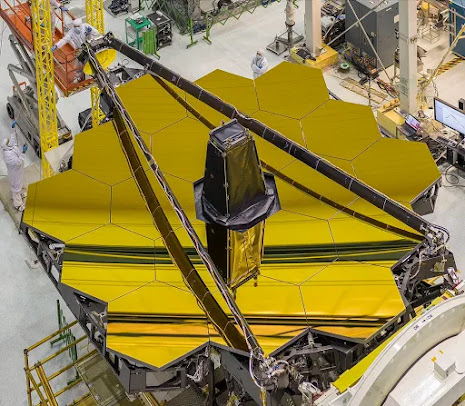 |
| Nasa James Webb telescope golden mirror | Image Credit: NASA/Chris Gunn |
The year 1608 was a pivotal year in the history of science - this year a Dutch spectacle maker invented binoculars - in the beginning, the telescopes were used only for entertainment or for pirates to use them on ships coming from afar. Used to see - it had no effect on astronomy - Galileo was the first scientist to turn the telescope towards the sky and thus began the golden age of astronomy.
For the next four hundred years, many large telescopes were installed on Earth to make detailed observations of astronomical objects - then a new revolution in the science of astronomy came in 1990 when the Hubble telescope was launched - the Hubble world's first telescope. Was orbiting the earth and working in space - this telescope observed astronomical objects from space (ie out of the Earth's atmosphere) and thus made it possible to observe many phenomena which are impossible to observe from the earth.
Hubble has been in operation for more than thirty years - it still has the distinction of being the most successful space telescope in history - but now the Hubble telescope is aging and will probably decommission in the next few years. So now we need a new space telescope that uses the most advanced and advanced technology from Hubble. The next telescope is called the James Webb telescope. How is this telescope different from the Hubble telescope?
James Webb Space Telescope Vs Hubble
Let's see
We know that the Hubble Telescope was named after the famous astronomer Hubble, who for the first time observed a galaxy other than the Milky Way galaxy with his observations and discovered that our universe is expanding. Earlier, scientists believed that our Milky Way galaxy was the entire universe and the universe was static. In contrast, the James Webb telescope was named after another astronomer, James Webb, who was NASA's administrator from 1961 to 1968. He was instrumental in making the Apollo mission a success.
When work on the Hubble Telescope began, it was estimated to cost about 340 million - but as the project progressed, so did the cost, and the launch of the Hubble took a total of five. Billions of dollars were spent - the story of the design of the James Webb telescope is similar - when the design of the James Webb telescope was started it was estimated that it would cost about one billion dollars - but so far nine More than a billion dollars has been spent.
Although the Hubble telescope was much larger than the space telescope, the James Webb telescope is much larger than the Hubble telescope - the Hubble telescope was about the size of a bus while the James Webb telescope is about half the size of a Boeing 737. The glass of the James Webb telescope is five times the diameter of the Hubble telescope and has a shield around it that protects it from the sun's rays. The size of this sun shield is the size of a tennis court.
The biggest difference between the Hubble and James Webb telescopes is their sensors that detect different parts of the electromagnetic spectrum - we can see a very small part of the electromagnetic spectrum called the visible spectrum - but the electromagnetic spectrum also has X-rays, gamma rays, ultraviolet rays whose frequency is higher than the frequency of light while the frequency of infrared and radio waves is lower than that of light - far more than the visible spectrum for observation of distant galaxies. Information is found in infrared and radio wave frequencies - most detectors in the Hubble telescope detect ultraviolet and visible spectrum, while James Webb telescope detectors are designed to detect infrared and radio frequencies. The telescope cannot detect - so with the James Webb telescope, we will be able to see galaxies and phenomena that are 13 billion light-years or more away from us.
The difference between the two telescopes is that the Hubble telescope is close to Earth, orbiting 570 km, while James Webb's orbit will be very far from Earth, which is called L1 point and 1.5 million km from Earth. The Sun, Earth, and Moon cannot reach this point because the Earth is in the opposite direction to the Sun, where the Earth is always in shadow. So Hubble's detectors are negative 220. It will be possible to keep it at Celsius - 15 times lower than Hubble's temperature - the James Webb telescope will be so far from Earth that it will not be possible to send any repair missions on it - so It will not be possible to fix any errors in the web telescope.
The purpose of the Hubble telescope was to discover new phenomena in the universe, and the Hubble telescope was extremely successful in its mission. Hubble discovered many new moons of comets, meteors, nebulae, and solar planets. Find out how galaxies, stars, and planets form but the purpose of the James Webb telescope is to understand the formation of the universe itself to help us figure out how the first few galaxies in the universe formed. It is possible that the James Webb telescope will be able to make a direct image of non-solar planets - only time will tell how successful the James Webb telescope will be, but if it works correctly, the James Webb in astronomy and cosmology The telescope will be another revolutionary step.